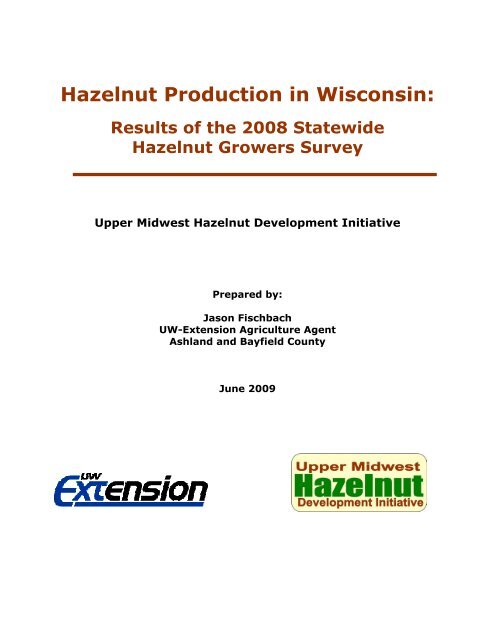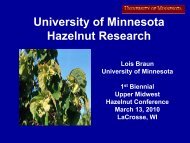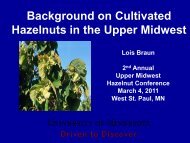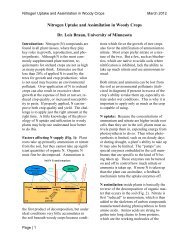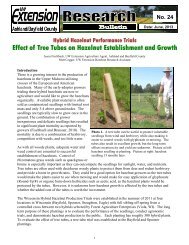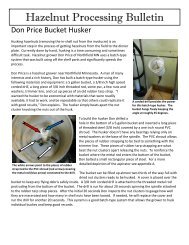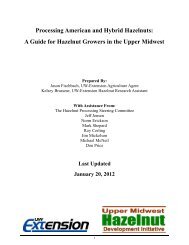Hazelnut Production in Wisconsin: - Upper Midwest Hazelnut ...
Hazelnut Production in Wisconsin: - Upper Midwest Hazelnut ...
Hazelnut Production in Wisconsin: - Upper Midwest Hazelnut ...
You also want an ePaper? Increase the reach of your titles
YUMPU automatically turns print PDFs into web optimized ePapers that Google loves.
<strong>Hazelnut</strong> <strong>Production</strong> <strong>in</strong> Wiscons<strong>in</strong>:<br />
Results of the 2008 Statewide<br />
<strong>Hazelnut</strong> Growers Survey<br />
<strong>Upper</strong> <strong>Midwest</strong> <strong>Hazelnut</strong> Development Initiative<br />
Prepared by:<br />
Jason Fischbach<br />
UW-Extension Agriculture Agent<br />
Ashland and Bayfield County<br />
June 2009
2008 Wiscons<strong>in</strong> <strong>Hazelnut</strong> Growers Survey Report<br />
<strong>Upper</strong> <strong>Midwest</strong> <strong>Hazelnut</strong> Development Initiative<br />
The <strong>Upper</strong> <strong>Midwest</strong> <strong>Hazelnut</strong> Development Initiative is an effort by<br />
organizations <strong>in</strong> Wiscons<strong>in</strong> and M<strong>in</strong>nesota to support the emerg<strong>in</strong>g hazelnut<br />
<strong>in</strong>dustry <strong>in</strong> the <strong>Upper</strong> <strong>Midwest</strong> through targeted research and development<br />
activities. This survey was conducted by the Wiscons<strong>in</strong> <strong>Hazelnut</strong> Research<br />
Team consist<strong>in</strong>g of Jason Fischbach, Agriculture Agent, UW-Extension<br />
Ashland/Bayfield County UW-Extension; Mike Demchik, Associate Professor<br />
of Forestry, UW-Steven’s Po<strong>in</strong>t; and Brent McCown, Gottschalk Dist<strong>in</strong>guished<br />
Professor, UW Madison Department of Horticulture.<br />
Acknowledgements<br />
The 2008 Wiscons<strong>in</strong> <strong>Hazelnut</strong> Growers Survey was conducted to better<br />
understand the extent of the hazelnut <strong>in</strong>dustry <strong>in</strong> WI and the challenges<br />
faced by hazelnut growers. Thanks to Brandon and Phil Rutter at Badgersett<br />
Research Corporation and Mark Shepard with Forest Agriculture Enterprises<br />
for their cooperation <strong>in</strong> distribut<strong>in</strong>g the survey to their customers. The<br />
survey was conducted <strong>in</strong> support of an on-farm hazelnut evaluation project<br />
funded by Cooperative State Research, Education, and Extension Service<br />
(CSREES).<br />
Background<br />
Bush-type hazelnuts (Corylus spp) are a multi-purpose nut crop with<br />
significant potential for the <strong>Upper</strong> <strong>Midwest</strong>. Nut yield data from s<strong>in</strong>gle-plant<br />
accessions of hybrids of C. americana, C. cornuta, and C. avellana have<br />
demonstrated yields of 4 tons/ha of husked nut <strong>in</strong> Nebraska (Hammond,<br />
2006) and up to 6 tons/ha <strong>in</strong> Wiscons<strong>in</strong> (Shepard, 2006), suggest<strong>in</strong>g<br />
significant potential for fresh-eat<strong>in</strong>g and process<strong>in</strong>g markets. Hybrid<br />
hazelnuts are equally well-suited as a feedstock source for the bioeconomy.<br />
Oil yields from the top 25 produc<strong>in</strong>g hybrid plants <strong>in</strong> a Nebraska plant<strong>in</strong>g<br />
yielded an equivalent of 892 lb oil/ac, nearly twice that of soybeans (Xu et<br />
at, 2007). Coppice wood, husks, and shell are well-suited for secondgeneration<br />
biofuels. Furthermore, perennial native plants have been<br />
proposed as foundations for the bioeconomy, due to their lower <strong>in</strong>put needs,<br />
higher net energy ratios, and more effective provision of ecosystem services<br />
compared to non-native annual plants (Tilman et. al, 2006; Cox et. al,<br />
2006). Multi-functional crops, such as bush-type hazelnuts can provide the<br />
essential ecosystem services of cycl<strong>in</strong>g nutrients, conserv<strong>in</strong>g soil, build<strong>in</strong>g<br />
soil fertility, stor<strong>in</strong>g carbon, and protect<strong>in</strong>g surface and groundwater quality<br />
more effectively than annual row crops. (Jordan et. al, 2007).<br />
Seed-propagated half-sibl<strong>in</strong>gs from early selections of crosses of C.<br />
americana, C. cornuta, and C. avellana have been sold to early adopters <strong>in</strong><br />
the <strong>Upper</strong> <strong>Midwest</strong> s<strong>in</strong>ce the 1990s. Collectively, these early-adopters of<br />
bush-type hazelnuts have deployed a significant population of genetically<br />
unique hazelnut plants.<br />
Survey work conducted by Rural Advantage and the University of M<strong>in</strong>nesota<br />
<strong>in</strong> 2007 identified 12 growers grow<strong>in</strong>g nearly 31,000 hazelnuts, this number<br />
does not <strong>in</strong>clude Badgersett Research Corporation, the primary grower and<br />
2
2008 Wiscons<strong>in</strong> <strong>Hazelnut</strong> Growers Survey Report<br />
breeder of hazelnuts <strong>in</strong> M<strong>in</strong>nesota. In 2008 the M<strong>in</strong>nesota <strong>Hazelnut</strong><br />
Foundation was established as a grower organization dedicated to the<br />
improvement of hazelnut genetics and commercialization of the crop.<br />
The number of growers and plants <strong>in</strong> Wiscons<strong>in</strong> is unknown, despite<br />
anecdotal evidence of a significant number of small plant<strong>in</strong>gs throughout the<br />
State.<br />
The 2008 <strong>Hazelnut</strong> Growers Survey was conducted to identify growers <strong>in</strong> WI,<br />
determ<strong>in</strong>e how many and where the hazelnut plants are <strong>in</strong> the State, and<br />
better understand the challenges faced by the growers. This <strong>in</strong>formation will<br />
be used by the University of Wiscons<strong>in</strong> researchers to more effectively<br />
support growers and commercialization of the hazelnut <strong>in</strong>dustry.<br />
Methods<br />
A survey was developed by the researchers with the <strong>Upper</strong> <strong>Midwest</strong> <strong>Hazelnut</strong><br />
Development Initiative and reviewed by the two ma<strong>in</strong> suppliers of bush-type<br />
hybrid hazelnut seedl<strong>in</strong>gs: Forest Agriculture Enterprises <strong>in</strong> WI and<br />
Badgersett Research Corporation <strong>in</strong> MN. The two-page survey is <strong>in</strong>cluded <strong>in</strong><br />
this report as Appendix A. The survey was sent by mail to 405 <strong>in</strong>dividuals <strong>in</strong><br />
WI that had purchased hazelnuts from one of the two organizations.<br />
Growers were asked to return the survey with<strong>in</strong> three weeks. In addition,<br />
growers were given directions on how to download the survey from the<br />
Bayfield County UW-Extension website, complete it electronically, and return<br />
it via email.<br />
In total, 66 people responded to the survey, 4 of whom reported hav<strong>in</strong>g no<br />
liv<strong>in</strong>g hazelnuts <strong>in</strong> 2008 due to 100% plant mortality or be<strong>in</strong>g a potential<br />
grower. The 16% response rate is certa<strong>in</strong>ly less than ideal, but perhaps<br />
understandable given the nature of new crop development. This survey is<br />
the first time the University of Wiscons<strong>in</strong> has reached out to the hazelnut<br />
growers <strong>in</strong> Wiscons<strong>in</strong> and it will take time for the relationship between the<br />
University and hazelnut growers to develop. As has occurred with grape<br />
growers <strong>in</strong> WI, it will also take time for the growers themselves to identify<br />
each other and start work<strong>in</strong>g together toward the collective development of<br />
the <strong>in</strong>dustry.<br />
The results from this survey are an <strong>in</strong>itial snapshot of the hazelnut <strong>in</strong>dustry<br />
<strong>in</strong> WI and, as such, yield valuable <strong>in</strong>formation as to the state of the <strong>in</strong>dustry.<br />
As the <strong>in</strong>dustry grows, surveys such as these will have higher response rates<br />
and more robust <strong>in</strong>formation.<br />
Results<br />
Plants and Acreage<br />
A total of 17,339 liv<strong>in</strong>g hazelnut plants were reported <strong>in</strong> the 66 returned<br />
surveys. Assum<strong>in</strong>g a 6’ plant by 10’ row spac<strong>in</strong>g, this equals roughly 24<br />
acres of hazelnuts. Figure 1 shows the distribution of growers by number of<br />
3
2008 Wiscons<strong>in</strong> <strong>Hazelnut</strong> Growers Survey Report<br />
plants. As is common with early-adopters of new crops, most of the growers<br />
are trial<strong>in</strong>g the hazelnuts with small plant<strong>in</strong>gs of 50 plants or less. A few<br />
growers have made significant <strong>in</strong>vestments <strong>in</strong> hazelnut plant<strong>in</strong>gs with<br />
plant<strong>in</strong>gs over 1000 plants.<br />
# of Plants # of Growers<br />
1000+ 4<br />
100-999 10<br />
50-99 5<br />
1-49 43<br />
Figure 1. The number of hazelnut growers by number of plants grown (N=62)<br />
Figure 2 shows the location of hazelnuts be<strong>in</strong>g grown <strong>in</strong> WI. The growers are<br />
widely distributed across Wiscons<strong>in</strong> with respondents from 33 of the 72<br />
Wiscons<strong>in</strong> counties. The wide distribution <strong>in</strong>dicates knowledge about<br />
hazelnuts as a potential crop has reached most areas of the State.<br />
County # of Pla nts County # of Pla nts<br />
Adams 5 Monroe 19<br />
Ashland 890 Oconto 40<br />
Bayfield 1465 Ozaukee 121<br />
Buffalo 35 Pep<strong>in</strong> 23<br />
Columbia 20 Pierce 213<br />
Crawford 253 Polk 112<br />
Dane 53 Portage 150<br />
Door 9 Rac<strong>in</strong>e 20<br />
Douglas 10 Richland 7975<br />
Fond du Lac 35 Sauk 321<br />
Grant 18 Shawano 48<br />
Green 75 Sheboygan 61<br />
Jackson 15 St. Croix 12<br />
Kenosha 46 Vernon 4340<br />
Kewaunee 8 Waukesha 18<br />
La Crosse 40 Wood 3<br />
Marathon 161 Not Specified 725<br />
Figure 2. Number of hazelnut plants by Wiscons<strong>in</strong> County.<br />
Figure 3 shows where the survey respondents sourced their hazelnut<br />
seedl<strong>in</strong>gs. The three largest suppliers of hazelnut seedl<strong>in</strong>gs are Badgersett<br />
Research Corporation, Forest Agriculture Enterprises, and the Wiscons<strong>in</strong><br />
Department of Natural Resources (DNR). The hazelnuts from Badgersett and<br />
Forest Agriculture are hybrids of Corylus avellana, Corylus americana, and<br />
Corylus cornuta, while the hazelnuts from the DNR are either C. americana or<br />
C. cornuta.<br />
4
2008 Wiscons<strong>in</strong> <strong>Hazelnut</strong> Growers Survey Report<br />
Re porte d Ha ze lnut Source s<br />
National Arbor Day Foundation<br />
Badgersett Research Corporation<br />
Extension<br />
Forest Agriculture Enterprises<br />
Griffith Nursery (DNR)<br />
Grimo Nursery<br />
Jung's<br />
Michigan State Ext. Service<br />
Miller Nursery<br />
Ozaukee Co.<br />
seedl<strong>in</strong>gs from largest seed<br />
Self grafted<br />
Smith Nursery<br />
St Lawrence Nurseries<br />
Not Known<br />
Figure 3. <strong>Hazelnut</strong> sources as reported by survey respondents<br />
<strong>in</strong> alphabetical order.<br />
Plant Mortality<br />
The survey asked how many hazelnuts were planted s<strong>in</strong>ce 2000 by year and<br />
from which nursery the plants were purchased. The respondents report<br />
plant<strong>in</strong>g 41,706 hazelnut plants with 17,339 still alive as of 2008. Across<br />
the state, the hazelnut plant<strong>in</strong>gs have experienced 58% mortality, which is<br />
an expensive and major problem faced by the growers. Mortality <strong>in</strong><br />
<strong>in</strong>dividual plant<strong>in</strong>gs ranged from 100% to 0% with an average of 40%. The<br />
survey did not specifically ask about cause of mortality, but based on written<br />
comments <strong>in</strong> the surveys the majority of the mortality is occur<strong>in</strong>g <strong>in</strong> the year<br />
of plant<strong>in</strong>g due to a multitude of causes, primarily rodents, deer, drought,<br />
transplant shock, and weeds.<br />
<strong>Hazelnut</strong> Yield<br />
Figure 4 shows the total hazelnut yield as reported by the 66 respondents by<br />
year s<strong>in</strong>ce 2004. Figure 5 shows the number of liv<strong>in</strong>g hazelnuts as of 2008<br />
and when they were planted. The large <strong>in</strong>crease <strong>in</strong> yield between 2007 and<br />
2008 is likely due to the 2000 plant<strong>in</strong>g com<strong>in</strong>g <strong>in</strong>to full production. It is<br />
unclear how much of the nut production has been harvested by growers and<br />
how accurately it has been weighed. Grower experience suggests significant<br />
hazelnut production doesn’t happen until year 6 at the earliest and later if<br />
competition from weeds has been severe. Figures 4 and 5 confirm this and<br />
demonstrate that the hazelnut plant<strong>in</strong>gs <strong>in</strong> WI are still relatively young and<br />
are only now beg<strong>in</strong>n<strong>in</strong>g to yield.<br />
5
2008 Wiscons<strong>in</strong> <strong>Hazelnut</strong> Growers Survey Report<br />
Year lbs<br />
2004 20<br />
2005 180<br />
2006 428<br />
2007 1389<br />
2008 20256<br />
Figure 4. Total hazelnut<br />
yield by year as reported<br />
by the growers (N=62).<br />
Liv<strong>in</strong>g Pla nts<br />
Year Planted (as of 2008)<br />
Prior to 2000 1284<br />
2000 3170<br />
2001 155<br />
2002 824<br />
2003 963<br />
2004 826<br />
2005 1367<br />
2006 3119<br />
2007 4146<br />
2008 1580<br />
Figure 5. The number of liv<strong>in</strong>g hazelnut<br />
plants as of 2008 by plant<strong>in</strong>g year.<br />
Grower Challenges<br />
The survey provided a list of challenges to hazelnut production and asked<br />
growers to choose the three they felt were most important. Figure 6 shows<br />
the percentage of growers that checked each of the listed challenges.<br />
Consistent with the mortality data, the most important challenge to growers<br />
is seedl<strong>in</strong>g mortality. Rodents, deer, and weed control are the next most<br />
important challenges, all of which are likely contributors to the low seedl<strong>in</strong>g<br />
survival. Interest<strong>in</strong>gly, there doesn’t appear to be serious <strong>in</strong>sect and disease<br />
problems. Most of the hazelnut plant<strong>in</strong>gs are fairly young and there is not<br />
much hazelnut production. As the plant<strong>in</strong>gs mature and production<br />
<strong>in</strong>creases, hazelnut husk<strong>in</strong>g, crack<strong>in</strong>g, and uniformity will likely become more<br />
important to the growers.<br />
The lack of technical assistance for hazelnut growers is an important issue to<br />
growers suggest<strong>in</strong>g that the University of Wiscons<strong>in</strong>, particularly UW-<br />
Extension, can play an important role <strong>in</strong> assist<strong>in</strong>g growers, especially with<br />
seedl<strong>in</strong>g establishment and management.<br />
6
2008 Wiscons<strong>in</strong> <strong>Hazelnut</strong> Growers Survey Report<br />
Challenges<br />
Percent<br />
Gett<strong>in</strong>g seedl<strong>in</strong>gs to survive 47<br />
Lack of technical assistance 24<br />
Rodent pests 24<br />
Weed control 21<br />
Deer browse 18<br />
Difficulty of husk<strong>in</strong>g/crack<strong>in</strong>g 17<br />
Cost of seedl<strong>in</strong>gs 17<br />
Variability of nut size 12<br />
Lack of irrigation 12<br />
Bird pests 9<br />
Availability of seedl<strong>in</strong>gs 8<br />
Insect pests 8<br />
Variability among plants 6<br />
Difficulty of harvest 5<br />
Plant disease 5<br />
Lack of markets 3<br />
Figure 6. The percent of survey respondents<br />
that <strong>in</strong>dicated the listed challenges were<br />
important to them. (N=66)<br />
Conclusion<br />
With hybrid hazelnuts planted <strong>in</strong> at least 33 WI counties it is clear there is<br />
considerable <strong>in</strong>terest <strong>in</strong> hazelnut production <strong>in</strong> WI. Furthermore, because all<br />
of the 17,000+ hybrid hazelnuts are propagated from seed, the growers have<br />
effectively deployed significant genetic diversity across the state, creat<strong>in</strong>g<br />
opportunities for mass selection and identification of promis<strong>in</strong>g locallyadapted<br />
genotypes.<br />
The high mortality rate of 60% is a major problem for growers, and it will be<br />
important to better understand what is caus<strong>in</strong>g the mortality. Certa<strong>in</strong>ly,<br />
basic agronomics of site preparation, time of plant<strong>in</strong>g, weed<strong>in</strong>g, water<strong>in</strong>g,<br />
and protection from herbivory are likely factors affect<strong>in</strong>g establishment, but<br />
quality of nursery stock and genetics are likely also play<strong>in</strong>g a role.<br />
The results of this survey <strong>in</strong>dicate two important support<strong>in</strong>g roles for the<br />
Wiscons<strong>in</strong> <strong>Hazelnut</strong> Research Team. The first is to provide outreach<br />
education to growers on the agronomics of grow<strong>in</strong>g woody shrubs,<br />
particularly site preparation and plant establishment. The second is to assist<br />
growers <strong>in</strong> evaluat<strong>in</strong>g the performance of their plants and help<strong>in</strong>g identify<br />
high-perform<strong>in</strong>g plants worthy of vegetative propagation and further<br />
breed<strong>in</strong>g efforts.<br />
Comments and questions regard<strong>in</strong>g this report should be directed to<br />
Jason Fischbach at 715-373-6104 ext 5 or<br />
jason.fischbach@ces.uwex.edu.<br />
7


